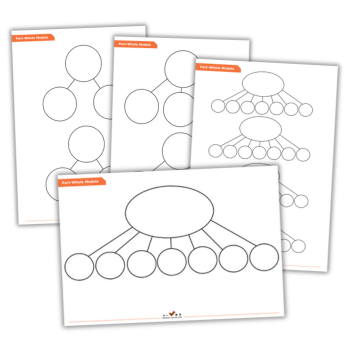These part-whole model templates have between two and seven smaller circles for every larger ‘whole’ circle. There’s a range of printing options, from one or two per page to multiple part-whole models per page.
What is a part-whole model?
A part-whole model is a simple yet powerful diagram that visually demonstrates how we can split numbers into parts that add up to make a whole.
Typically, the model consists of one large circle (or box) representing the whole number. There is then two or more smaller circles for the parts.
By breaking down a number into its components, children can understand the flexible relationships within numbers. This lays a solid foundation for addition, subtraction and even more advanced concepts as they progress.
How to complete a part-whole model
To complete a part-whole model, students first identify the whole number they are working with. They place this in the largest circle or box on the template.
Next, they consider two (or more) numbers that combine to form this whole. You then write these numbers, or ‘parts,’ in the smaller circles.
For example, if the whole number is 15, pupils might break it down into parts such as 10 and 5, visualising that 10 + 5 equals 15.
This process not only reinforces addition facts but also supports understanding of subtraction: if the whole is 15 and one part is 10, the other part must be 5 (15 – 10 = 5).
Using part-whole models for different operations
As pupils grow more confident, the blank templates can be used for various calculations beyond simple addition and subtraction.
For instance, students can explore multiplication by dividing 20 into four parts of 5, or they can experiment with division by determining that three parts of 4 add up to a whole of 12.
This adaptable approach means that part-whole models can support learning in a range of mathematical areas, from number bonds in KS1 to algebraic concepts in upper years.
Versatile classroom resource
Blank part-whole models are a flexible and essential resource for KS1 and KS2 teachers, providing pupils with a visual tool to make connections between numbers and understand the relationships within mathematical operations.
These worksheets help build a strong foundation in mathematical reasoning, giving students the confidence and skills to tackle more complex maths challenges across the curriculum.
Primary Maths Hub was founded in 2022 by Sarah Farrell and Andrew Jennings and offers high-quality maths resources. Follow on X at @PrimaryMathsHub.











